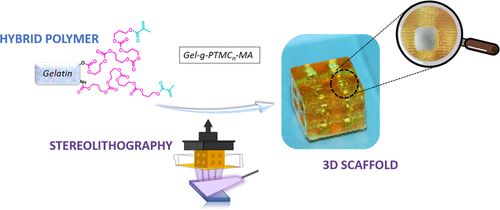当前位置:
X-MOL 学术
›
Biomacromolecules
›
论文详情
Our official English website, www.x-mol.net, welcomes your
feedback! (Note: you will need to create a separate account there.)
Photoprintable Gelatin-graft-Poly(trimethylene carbonate) by Stereolithography for Tissue Engineering Applications
Biomacromolecules ( IF 5.5 ) Pub Date : 2021-08-16 , DOI: 10.1021/acs.biomac.1c00687 Thomas Brossier 1, 2 , Gael Volpi 2 , Jonaz Vasquez-Villegas 3 , Noémie Petitjean 3, 4 , Olivier Guillaume 5 , Vincent Lapinte 1 , Sébastien Blanquer 1
Biomacromolecules ( IF 5.5 ) Pub Date : 2021-08-16 , DOI: 10.1021/acs.biomac.1c00687 Thomas Brossier 1, 2 , Gael Volpi 2 , Jonaz Vasquez-Villegas 3 , Noémie Petitjean 3, 4 , Olivier Guillaume 5 , Vincent Lapinte 1 , Sébastien Blanquer 1
Affiliation

|
The stereolithography process is a powerful additive manufacturing technology to fabricate scaffolds for regenerative medicine. Nevertheless, the quest for versatile inks allowing one to produce scaffolds with controlled properties is still unsatisfied. In this original article, we tackle this bottleneck by synthesizing a panel of photoprocessable hybrid copolymers composed of gelatin-graft-poly(trimethylene carbonate)s (Gel-g-PTMCn). We demonstrated that by changing the length of PTMC blocks grafted from gelatin, it is possible to tailor the final properties of the photofabricated objects. We reported here on the synthesis of Gel-g-PTMCn with various lengths of PTMC blocks grafted from gelatin using hydroxy and amino side groups of the constitutive amino acids. Then, the characterization of the resulting hybrid copolymers was fully investigated by quantitative NMR spectroscopy before rendering them photosensitive by methacrylation of the PTMC terminal groups. Homogeneous composition of the photocrosslinked hybrid polymers was demonstrated by EDX spectroscopy and electronic microscopy. To unravel the individual contribution of the PTMC moiety on the hybrid copolymer behavior, water absorption, contact angle measurements, and degradation studies were undertaken. Interestingly, the photocrosslinked materials immersed in water were examined using tensile experiments and displayed a large panel of behavior from hydrogel to elastomer-like depending on the PTMC/gel ratio. Moreover, the absence of cytotoxicity was conducted following the ISO 10993 assay. As a proof of concept, 3D porous objects were successfully fabricated using stereolithography. Those results validate the great potential of this panel of inks for tissue engineering and regenerative medicine.
中文翻译:

用于组织工程应用的立体光刻可光印明胶接枝聚(碳酸三亚甲基酯)
立体光刻工艺是一种强大的增材制造技术,用于制造再生医学支架。然而,对允许生产具有可控特性的支架的多功能墨水的探索仍未得到满足。在这篇原始文章中,我们通过合成一组由明胶-接枝-聚(三亚甲基碳酸酯)(Gel - g- PTMC n)组成的可光加工杂化共聚物来解决这个瓶颈。我们证明了通过改变从明胶接枝的 PTMC 块的长度,可以定制光制造物体的最终特性。我们在此报道了Gel - g- PTMC n的合成使用组成氨基酸的羟基和氨基侧基从明胶接枝不同长度的 PTMC 块。然后,在通过 PTMC 端基的甲基丙烯酸化使它们具有光敏性之前,通过定量 NMR 光谱充分研究了所得杂化共聚物的表征。EDX 光谱和电子显微镜证明了光交联杂化聚合物的均匀组成。为了阐明 PTMC 部分对杂化共聚物行为的个体贡献,进行了吸水率、接触角测量和降解研究。有趣的是,使用拉伸实验检查了浸入水中的光交联材料,并根据 PTMC/凝胶比率显示了从水凝胶到类弹性体的大量行为。而且,根据 ISO 10993 测定进行无细胞毒性。作为概念证明,使用立体光刻技术成功制造了 3D 多孔物体。这些结果证实了这组墨水在组织工程和再生医学方面的巨大潜力。
更新日期:2021-09-13
中文翻译:

用于组织工程应用的立体光刻可光印明胶接枝聚(碳酸三亚甲基酯)
立体光刻工艺是一种强大的增材制造技术,用于制造再生医学支架。然而,对允许生产具有可控特性的支架的多功能墨水的探索仍未得到满足。在这篇原始文章中,我们通过合成一组由明胶-接枝-聚(三亚甲基碳酸酯)(Gel - g- PTMC n)组成的可光加工杂化共聚物来解决这个瓶颈。我们证明了通过改变从明胶接枝的 PTMC 块的长度,可以定制光制造物体的最终特性。我们在此报道了Gel - g- PTMC n的合成使用组成氨基酸的羟基和氨基侧基从明胶接枝不同长度的 PTMC 块。然后,在通过 PTMC 端基的甲基丙烯酸化使它们具有光敏性之前,通过定量 NMR 光谱充分研究了所得杂化共聚物的表征。EDX 光谱和电子显微镜证明了光交联杂化聚合物的均匀组成。为了阐明 PTMC 部分对杂化共聚物行为的个体贡献,进行了吸水率、接触角测量和降解研究。有趣的是,使用拉伸实验检查了浸入水中的光交联材料,并根据 PTMC/凝胶比率显示了从水凝胶到类弹性体的大量行为。而且,根据 ISO 10993 测定进行无细胞毒性。作为概念证明,使用立体光刻技术成功制造了 3D 多孔物体。这些结果证实了这组墨水在组织工程和再生医学方面的巨大潜力。











































 京公网安备 11010802027423号
京公网安备 11010802027423号